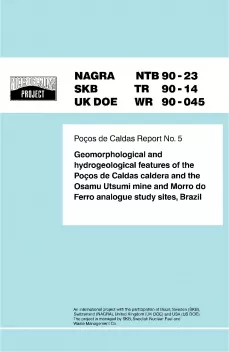
Technical Report NTB 90-23
Poços de Caldas Report No. 5Geomorphological and hydrogeological features of the Poços de Caldas caldera and the Osamu Utsumi mine and Morro do Ferro analogue study sites, Brazil
The Osamu Utsumi mine and Morro do Ferro study sites lie within the Poços de Caldas plateau which is roughly circular in outline with a diameter of 35 km and an area of approximately 800 m2 Its general altitude lies between 1300 and 1600 m. The plateau is the eroded form of a caldera which was initially intruded some 80 million years ago.
Geomorphologically, both sites occupy watershed areas adjacent to small streams in the centre of the plateau. The climate of the area has a marked wet season from November to April and is dry the rest of the year. The streams are ephemeral in their upper reaches, tending to dry up in the dry season as they are fed by a declining base flow. In the wet season they exhibit flash floods fed by high-intensity rainfall causing overland flow. The wet season also provides recharge to the groundwater. Natural slopes are steep and the original vegetation was thin forest cover which is now restricted to the valley bottoms; usable slopes have poor quality grass cover used for cattle grazing. The plateau is a stable feature and its surface has been eroding at an average rate of 12 m per million years over a period of 50 million years.
The mine geology is dominantly volcanic to subvolcanic phonolites that have been hydrothermally altered. Fracturing of the rock is extensive. Downward diffusion of oxygen in groundwaters during deep weathering has produced a distinct redox zone seen as a colour change from green/grey to brown/yellow. Morro do Ferro has a more weathered version (laterite/clay) of the same geology penetrated by magnetite breccias dykes. Whilst the area surrounding Morro do Ferro remains untouched, that around the mine has been seriously disturbed by mining activity which has penetrated the water table. The existing mine has modified groundwater flow patterns and disturbed the movement of oxidising and reducing waters.
